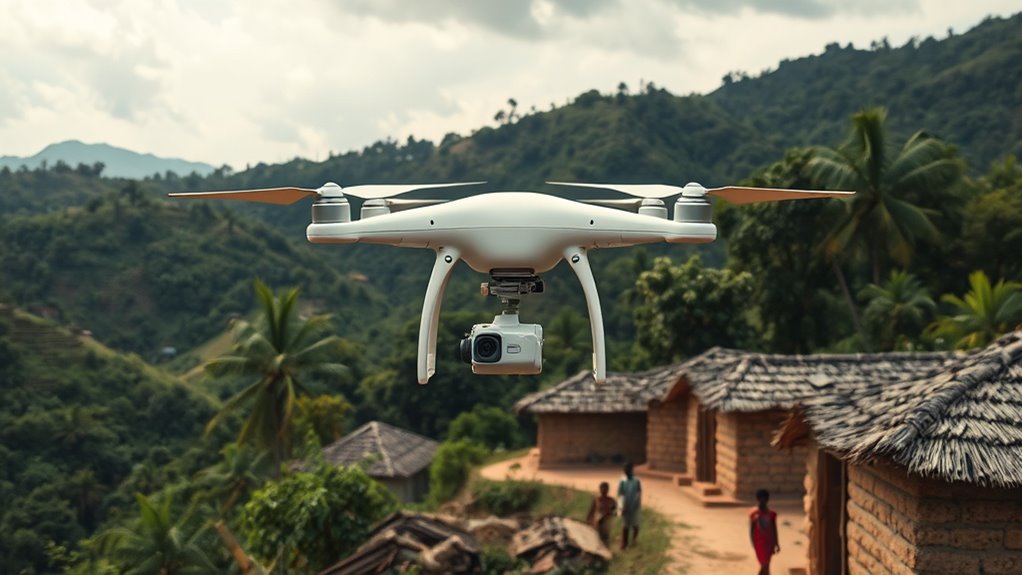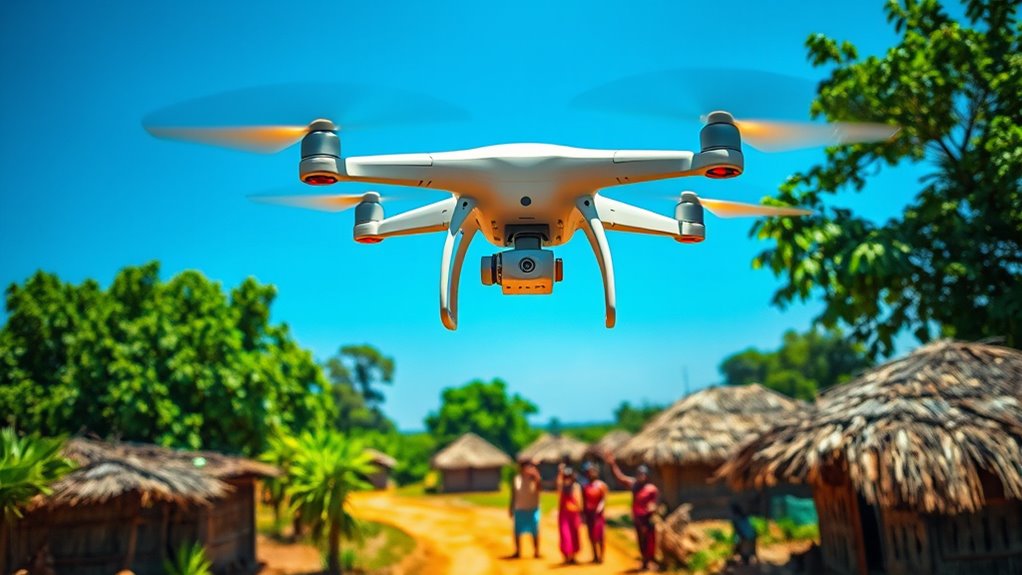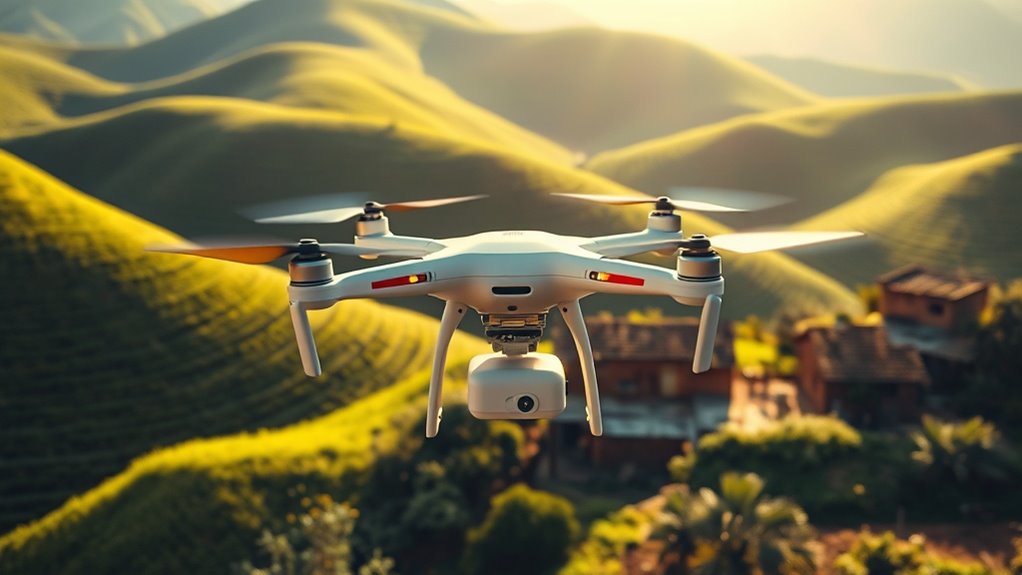Medicine-delivery drones are revolutionizing healthcare access in remote villages by quickly transporting essential medicines and supplies. They use advanced autonomous navigation, sensors, and GPS to navigate tough terrain safely. While regulatory and weather challenges exist, successful programs by companies like Zipline show how these drones bypass logistical delays. If you want to discover how this innovative technology continues to improve lives and what lies ahead, there’s more to uncover.
Key Takeaways
- Drones deliver essential medicines quickly to remote villages, overcoming geographical barriers and improving healthcare access.
- Autonomous navigation and advanced sensors ensure safe, reliable deliveries in challenging terrains and weather conditions.
- Regulatory frameworks and community engagement are vital for safe operation and building local trust in drone delivery programs.
- Initiatives by organizations like Zipline and Wing demonstrate successful, scalable medical supply deliveries via drones.
- Future developments aim to enhance sustainability, address ethical concerns, and expand drone use for broader healthcare impact.
How Drones Are Changing Healthcare Access in Remote Areas

Drones are revolutionizing healthcare access in remote areas by delivering medical supplies quickly and efficiently. However, drone regulations are essential to ensure safe operations and gain government approval. Clear policies help prevent accidents and establish standards for flying in diverse environments. Community acceptance also plays a critical role; when locals understand that drones improve emergency response and supply delivery, they’re more likely to support their use. Building trust involves engaging communities early, addressing concerns, and demonstrating safety measures. As regulations evolve and communities embrace drone technology, healthcare delivery in remote areas becomes faster and more reliable. This combination of regulatory oversight and community acceptance paves the way for widespread adoption of medicine-delivery drones, ultimately saving lives and bridging healthcare gaps.
Key Technologies Powering Medicine-Delivery Drones

Advancements in key technologies have made medicine-delivery drones more efficient and reliable. Autonomous navigation systems allow your drone to accurately and safely reach remote villages without constant human control, even in complex environments. These systems use advanced sensors, GPS, and computer vision to detect obstacles and adjust routes in real-time. Payload management is equally critical, ensuring your drone can handle delicate medical supplies securely and efficiently. Modern payload systems monitor weight, balance, and temperature, preventing damage and maintaining medicine integrity during flight. High refresh rates and precise control are essential for smooth operation of these delivery systems. Together, autonomous navigation and payload management enable your drone to deliver medicines swiftly and safely, even in challenging terrains. These innovations form the backbone of reliable, scalable drone delivery networks that bring essential healthcare supplies directly to those who need them most.
Challenges and Limitations of Drone-Based Medical Supply Systems

What are the main hurdles preventing widespread adoption of drone-based medical supply systems? Regulatory hurdles often slow progress, with strict rules delaying approvals and raising costs. Logistical complexities also pose challenges, as coordinating drone routes, managing batteries, and ensuring timely deliveries in remote areas can be overwhelming. These issues can cause delays, reduce reliability, and increase expenses. To evoke emotion:
| Challenge | Impact | Emotional Resonance |
|---|---|---|
| Regulatory hurdles | Delays life-saving supplies | Frustration and urgency |
| Logistical complexities | Risk of missed or damaged deliveries | Anxiety for vulnerable patients |
| Weather conditions | Flight cancellations, safety risks | Fear and uncertainty |
| Infrastructure gaps | Limited support for drone operation | Feelings of helplessness |
Furthermore, unpredictable environmental factors like weather conditions can significantly hinder drone operations, adding to the overall challenges faced in delivering critical medical supplies.
Real-World Examples of Drone Medicine Delivery Initiatives

Have you seen how drone delivery programs are transforming healthcare in remote communities? These initiatives are already making a difference. Imagine a drone flying over rugged terrain to deliver life-saving medicines. Picture it:
Drone delivery is revolutionizing healthcare access in remote communities worldwide.
- Landing precisely outside a village clinic, dropping off vaccines.
- Navigating around regulatory hurdles to ensure timely deliveries.
- Streamlining supply chain management by bypassing traditional delays.
In real-world examples, organizations like Zipline and Wing have successfully implemented such systems, overcoming logistical challenges. They work closely with regulators to meet safety standards and adapt to local regulations. These initiatives demonstrate how drones can enhance supply chain management, ensuring medicines reach even the most isolated areas quickly and reliably. Such efforts are proof that drone medicine delivery is no longer just a concept but a vital tool in healthcare. Incorporating Float Mounting Textile Art techniques can help in creating durable, lightweight packaging for sensitive medical supplies transported by drones.
Future Prospects for Drone-Driven Healthcare Solutions

As drone medicine delivery proves its value in remote communities, the potential for expanding these solutions grows rapidly. You’ll likely see more widespread use of drones to improve healthcare access, especially in hard-to-reach areas. However, ethical concerns remain, such as data privacy and safety regulations that must be addressed. Additionally, environmental impact is a key consideration; while drones can reduce emissions compared to traditional transportation, their manufacturing and energy use may pose ecological challenges. Future advancements should focus on balancing technological progress with responsible practices. Developing sustainable drone systems and establishing clear ethical guidelines will be essential. Forsale 100 As these issues are managed, drone-driven healthcare solutions could revolutionize medical delivery, making care faster, safer, and more accessible worldwide.
Frequently Asked Questions
What Are the Regulatory Hurdles for Drone Medical Deliveries?
You need to navigate several regulatory hurdles for drone medical deliveries. Ensuring legal compliance with aviation authorities is essential, which includes obtaining proper licenses and adhering to flight restrictions. You also have to contemplate insurance policies to cover potential accidents or damages. These regulations aim to keep operations safe and legal, but they can slow down deployment and require ongoing adjustments as policies evolve.
How Do Drones Ensure the Safety of Fragile Medical Supplies?
You guarantee the safety of fragile medical supplies by following strict safety protocols and using specialized fragile cargo handling techniques. Drones are equipped with cushioned compartments and shock absorbers to prevent damage during flight. You also perform regular safety checks and monitor flight conditions to minimize risks. This careful approach guarantees that delicate items, like vaccines or organs, arrive intact, maintaining their efficacy and ensuring patient safety.
What Training Is Required for Drone Operators in Healthcare?
You need to complete thorough drone maintenance training, earn operator certification, and learn safety protocols to operate healthcare drones effectively. This includes understanding flight regulations, mastering navigation systems, and practicing emergency procedures. You’ll also focus on drone maintenance techniques to guarantee peak performance and safety. By staying current on certifications and honing your skills, you ensure reliable deliveries, safety for patients, and smooth operations, making healthcare access more efficient and trustworthy.
How Do Weather Conditions Affect Drone Delivery Schedules?
Weather influences drone delivery schedules profoundly, causing potential delivery delays. You need to stay aware of weather conditions like rain, wind, or fog, which can hinder drone flights or force cancellations for safety reasons. When weather worsens, your delivery plans might be disrupted, so it’s crucial to monitor forecasts closely and plan accordingly to guarantee timely deliveries and avoid unnecessary delays.
What Are the Privacy Concerns Related to Drone Surveillance?
Like a hawk watching over its territory, drones can raise privacy concerns. You might worry about data privacy and surveillance ethics, as drones capture images or data without clear consent. This intrusion can feel invasive, making you question how your personal information is used or stored. It’s essential to regulate drone activities to protect individual rights, ensuring surveillance remains transparent and respectful of everyone’s privacy.
Conclusion
As you see, medicine-delivery drones are transforming healthcare in unexpected ways. It’s almost like they’ve become invisible messengers, silently bridging gaps and bringing essential care where it’s needed most. With each flight, you realize how technology and compassion converge, making remote villages feel closer to the world’s healthcare advancements. As these drones soar into the future, you can’t help but wonder—perhaps it’s coincidence that they’re delivering hope alongside medicine, rewriting the story of access itself.










